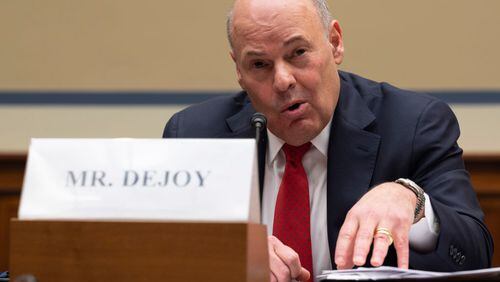Secrecy and autonomy
The five members of the Georgia Board of Pardons and Paroles operate with near-absolute autonomy. They do not answer to legislators, judges, or even the governor who appointed them to their jobs, which carry a base salary of $135,000 a year.
The board does not meet in public to consider cases. It announces no justification for its decisions.
In weighing the pleas of death row inmates to have their sentences commuted to life in prison, board members essentially are free to base their votes on any grounds they choose. They hear arguments from supporters and opponents of each clemency request in private, and neither side hears the other’s presentation.
Almost all the board’s files are classified as “confidential state secrets.”
The breadth of discretion the board enjoys and the secrecy surrounding its decisions can frustrate opponents of clemency as well as advocates for it. State Rep. Kevin Tanner, R-Dawsonville, was outraged last year when the board commuted the death sentence of murderer Tommy Waldrip.
In response, Tanner introduced a bill in the current legislative session that would require the board to follow strict standards in weighing clemency and to explain the basis for each decision afterward. The measure passed the House but is still awaiting Senate action with the end of the session just days away.
RELATED: Who wins clemency in Georgia?
Kelly Gissendaner, Tommy Waldrip, Harold Williams, Freddie Davis and Charles Harris Hill were convicted of murder by Georgia juries and sentenced to die. Each of them had an accomplice who actually performed the killing but got a lesser sentence.
Unlike Gissendaner, the men are no longer on death row; over a period of several decades, members of the Georgia Board of Pardons and Paroles commuted their sentences to life in prison. The board does not reveal its reasoning, but each man's lawyers argued – as Gissendaner's counsel did in her unsuccessful clemency plea – that his sentence was out of proportion to that of his accomplice.
In addition to that claim, Gissendaner’s lawyers produced copious evidence that she has become a new woman while in prison: finding God; deeply repenting of her crime; working tirelessly to counsel other inmates and defuse conflicts inside the walls.
Similarly, the clemency petitions of Daniel Greene, Samuel David Crowe, Willie James Hall and William Moore included evidence that, despite their terrible crimes, they were or had become men of good character. Their pleas succeeded while hers failed.
Gissendaner, who twice escaped execution at the last minute earlier this year (once because of bad weather, once because of concerns that the lethal injection drug had spoiled), has renewed her appeal for clemency. It's not clear whether she will get another hearing; the state intends to set a new execution date as soon as it can secure a fresh batch of the drug.
Numerically speaking, it is never a surprise when a death row inmate’s application for clemency fails. In Georgia and nationwide, the vast majority of pleas are rejected. Georgia has denied 63 inmates since the U.S. Supreme Court lifted a moratorium on executions in 1976. Only 11 sentences have been commuted during that time from death to life in prison.
Nevertheless, many who follow death penalty issues closely felt that Gissendaner made a strong case for clemency.
“I was a little surprised that clemency wasn’t granted,” said Anne Emanuel, an emeritus professor of law at Georgia State University. “It’s a compelling case, considering both her redemption and the proportionality issue.”
Looking for patterns or making comparisons among clemency cases is tricky. The board operates in secrecy and without guidelines for when it should grant or deny a prisoner’s plea. As an executive function rather than a judicial one, clemency is not subject to the same procedural safeguards that operate in court – or to any requirement that the board act consistently from case to case or decade to decade.
Nevertheless, some critics of the death penalty say that in rejecting Gissendaner’s petition, the parole board cast doubt on its own even-handedness and demonstrated why the public deserves a window onto its actions.
“Cases like this, viewed in context, point to the seeming arbitrariness of clemency and its inadequacy as a failsafe,” said Robert Dunham, executive director of the Death Penalty Information Center.
During the trial, Gwinnett County prosecutors told jurors that even though Gissendaner did not physically kill her husband, she was at least as culpable as her lover, with whom she plotted the death.
District Attorney Danny Porter did not respond to interview requests for this article, but he repeated those sentiments on the eve of Gissendaner’s February clemency hearing.
“She didn’t actually strike the blow with the night stick, and she didn’t actually stab him four or five times, ” Porter told The Atlanta Journal-Constitution. “(But) she was the instigator.”
‘No excuses for what I did’
According to her clemency petition, Gissendaner would be the first person in Georgia since 1976, and only the sixth in the nation, to die for a crime actually carried out by another person.
In Gissendaner’s case, that person was her lover, Gregory Owen. The two of them planned the killing of Doug Gissendaner, with whom Kelly had three children. On Feb. 7, 1997, Owen carried out the plan, abducting Doug Gissendaner and stabbing him to death in a wooded area near Dacula.
Gwinnett County prosecutors offered both Owen and Kelly Gissendaner a plea deal: a life sentence in return for a guilty plea and testimony against the other one. Gissendaner rejected the deal; Owen took it.
At Gissendaner’s trial, Owen testified that Kelly provided the knife used in the murder and came to the woods afterward to make sure her husband was dead. According to Gissendaner’s clemency plea, he later recanted those assertions and said that another person, whom he has not named, helped him carry out the murder.
In the petition, Gissendaner says she accepts full responsibility for her part in the murder and feels deep remorse for the pain it caused her children and her husband’s family.
“There are no excuses for what I did,” she writes. “I am fully responsible for my role in my husband’s murder. I had become so self-centered and bitter about my life and who I had become, that I lost all judgment. I will never understand how I let myself fall into such evil, but I have learned first-hand that no one, not even me, is beyond redemption through God’s grace and mercy.”
‘She gradually took responsibility’
The application includes testimonials from dozens of people, including nine present and former prison employees, who describe Gissendaner’s intense religious faith and study of theology, her exemplary behavior while in prison, her compassion and her positive influence on other inmates and troubled youth who are brought to visit the prison.
The Rev. Sally Purvis, Gissendaner’s pastoral counselor since 1999, wrote that over the years “she gradually took responsibility for ‘what happened to her,’ and she started to look hard at what she had done.
She realized over time that her real work wasn’t to challenge a system but to look hard at her own soul and make peace – with God, with the world, and with herself.”
Jailhouse conversions are nothing new, noted Elizabeth Rapaport, an emeritus professor of law and philosophy at the University of New Mexico. Even when genuine, Rapaport said, religious convictions “are by no means a straight shot” at clemency.
Gissendaner's request for a new hearing claims that even the former head of Georgia's parole board, Gen. James Donald, once voiced the expectation that Gissendaner's personal transformation would win her clemency. There is no independent record of such a statement by Donald, who met the inmate when she was honored for her theological studies in prison.
Her petition says that Donald told others more than once that “Ms. Gissendaner did not need to worry about clemency as it was a foregone conclusion.” But Donald has since left the board and was unavailable last week to confirm that he made such statements.
‘Most have their finger in the wind’
The clemency process has its roots in the divine right of kings, dating to feudal times, when a monarch could spare a condemned prisoner at will. In some states, the governor wields clemency power. In Georgia, that power rests with five board members appointed by the governor but not answerable to the governor for their decisions.
Because they are political appointees, the process is, in the broad sense, political, although board members are supposed to be insulated from the political passions that may surround any particular case. That, in fact, is one of the rationales for the secrecy in which they operate.
“Most of these guys have their finger in the wind,” Rapaport said, speaking broadly about the national context.
Georgia law spells out some materials the board should review in clemency cases, but not specific grounds for clemency. In practice, three factors seem to weigh heavily, according to a 2006 analysis by the American Bar Association: “(1) proportionality of the inmate’s death sentence, (2) the mental condition of the inmate, and (3) the behavior of the inmate while in prison combined with support for commutation.”
Although clemency is part of the legal process, the board brings to bear considerations sometimes absent from it, such as morality, redemption and a sort of schoolyard standard of fairness.
“It’s nothing more than grace,” said Millie Dunn, a lawyer who has represented death row inmates before the parole board.
‘Doug is the true victim of this crime’
It is also the only opportunity for those damaged by the crime to directly state their wishes. During the sentencing phase of the trial, they may testify about the crime’s impact on them, but not say what punishment they desire. In the cases of some of the men spared the death penalty by Georgia’s parole board, the victim’s family members expressed support for clemency.
Two of Gissendaner’s three children are quoted in her clemency petition. They say they believe her repentance is genuine. They also say she has done her best to rebuild her relationships with them and to be a good mother. And they say they will suffer anew if she is executed.
But Doug Gissendaner’s parents and siblings have publicly called for the death sentence to stand.
“Doug is the true victim of this premeditated and heinous crime,” they said in a statement earlier this month. “We, along with our friends and supporters and our faith, will continue fighting for Doug until he gets the justice he deserves no matter how long it takes.”
Presumably, they repeated those calls at her clemency hearing, although there is no way to know. The board hears separately from those who support clemency and those who oppose it; not even Gissendaner’s lawyers know who spoke against her or what they said.
The gender factor
The thing that clearly sets Gissendaner’s case apart, her gender, is something the board is supposed to disregard. At the same time, the novelty of a woman on the brink – only 15 female inmates have been executed nationwide since 1976 – means the case was bound to draw outsized media attention.
In theory, gender can play out in several ways in the courtroom and the clemency process, said Rapaport, who has studied how gender influences death penalty cases.
The conventional wisdom might be that society would be more hesitant to execute a woman than a man. On the other hand, the deadly, calculating “black widow” is a figure of fascination in popular culture, and revulsion for a woman who commits such an “unwomanly” act might weigh against the defendant.
Dunham of the Death Penalty Information Center said only one thing is clear: board members were out of line if they let Gissendaner’s gender influence their decision in any way whatsoever.
“If it was a consideration, that would be improper,” he said.
While the state tries to clear away the obstacles to executing her, Gissendaner’s lawyers are pursuing a two-pronged strategy. The first is an attack on the execution drug and the secrecy surrounding its manufacture. The second is aimed at getting a new clemency hearing.
In a petition pending before the federal 11th Circuit Court of Appeals, her lawyers urge the board to hear testimony from prison system employees who support Gissendaner’s clemency plea. According to the petition, those employees were dissuaded from testifying at the original hearing by memo written by the warden of the prison where Gissendaner is housed, who is new to that post.
Testimony from a former warden, among others, “would have left no doubt that a grant of clemency is supported in this case,” Gissendaner’s lawyers wrote.
About the Author






